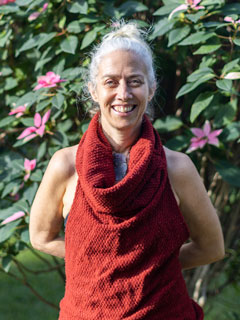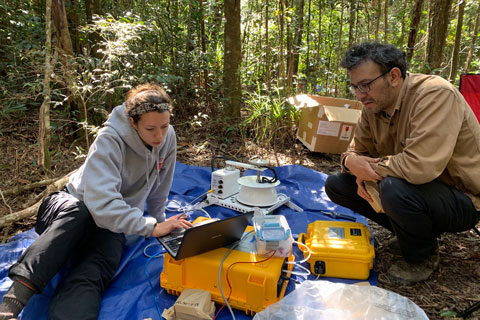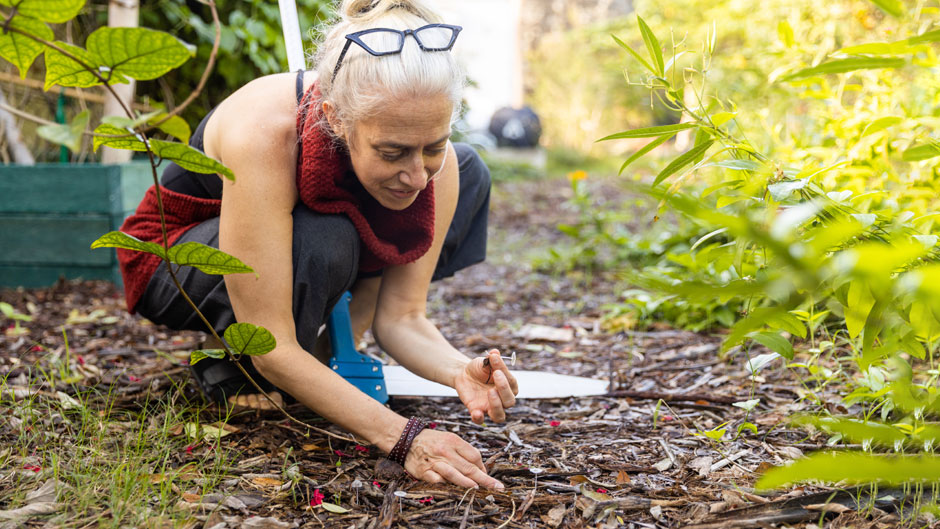Most people understand that trees are a critical natural resource, locking away carbon and releasing oxygen as they grow.
But few understand what happens to the carbon after trees die.

Amy Zanne, who joined the University of Miami this fall as the new Aresty Endowed Chair in Tropical Ecology, is trying to answer that question.
“We are interested in how trees break down and what happens to the carbon they release in that process,” said Zanne, a professor in the College of Arts and Sciences’ Department of Biology. “And since wood is one of the largest biological stores of carbon, we also want to know how that carbon travels up into the atmosphere as it decays, as well as whether this release slows down or speeds up with global change.”
It’s a complex topic that not many scientists explore, but Zanne’s keen ability to collaborate with researchers across the world helped fuel her interest. She is currently wrapping up a multiyear global study to help determine whether dead wood typically decomposes faster from microbes, such as fungi—the most common route globally—or whether termites are playing a greater role in breaking down dead trees.
Lately, termites may be tipping the scales. As temperatures rise with climate change, the habitat of termites, which were once limited to the tropics, is likely expanding, Zanne said.
“Globally, fungi are more important for decay, but they need water to decay wood. So, with global warming, I expect the role of termites will increase quite a bit,” said Zanne, who is also a 2021 Fellow of the Ecological Society of America. “And since we know that many termites release carbon gases as both methane and carbon dioxide, this has implications for speeding up or slowing down global change.”
She is paying close attention to tropical areas where wet and dry regions border each other. This may help her lab to understand if different gases emanate from dead trees depending on their environment. For example, trees that decompose with the help of termites may release more methane.
“Both living and dead wood look like they may be unrecognized sources of methane,” Zanne said. “And since methane is a 30-fold worse greenhouse gas than carbon dioxide, these altered carbon pathways may interact with rates of global change.”
To conduct her research, Zanne spends time scrutinizing dead trees in places like Far North Queensland, Australia, near the Great Barrier Reef, where humid rainforests neighbor dry savannahs. She also does research in central Brazil, where some of the largest termites in the world build mounds the size of a house.
The chance to live in the tropics attracted her to Miami, where Zanne wants to explore how sea level rise may be affecting tree death and carbon release. She is also working on building a new field site in Brazil and hopes to teach courses there.
But Zanne didn’t always know she wanted to study trees. Growing up in New Hampshire, she enjoyed hiking, but planned to become a geneticist. But on a study abroad program in Kenya, she realized that she preferred working outdoors.

In graduate school, she studied why trees were successful in certain habitats in Uganda. Later, with collaborators, she created what’s known as the “timetree,” an evolutionary map showing the relationships between land plants around the world. It’s a reference that many ecologists and evolutionary biologists use today, including biology assistant professor Michelle Afkhami, who studies interactions between fungi and living plants.
The two ecologists met at a workshop where they created a database about the useful traits of fungi. Today, that resource helps researchers understand how different species decompose, but it could also be useful to farmers or conservationists who want to learn how fungus and plant species cooperate.
“Amy is great at bringing together researchers to answer questions that can add meaningful progress to science and help generate conclusions beyond the scope of what we can do as individual scientists,” Afkhami said.
Zanne’s research also explores the role of wood density in trees. This can shed light on a tree’s growth rate, whether it is susceptible to drought, and how much carbon it contains. Ken Feeley, an associate professor of biology and the Smathers Chair of Tropical Tree Ecology, studies the composition and structure of forests, as well as how they are responding to global change. Feeley has used a database Zanne created about global wood densities to bolster his work.
“Wood density is made up of carbon, so when we are trying to put together models or questions about the role of plants and forests in the global carbon cycle, knowing wood density is absolutely crucial,” said Feeley.
“Amy’s work is helping to characterize the complete carbon cycle of forests, so we can understand how they play into the global carbon budget,” he added. “When a tree dies, all of the carbon it accumulated over its lifetime will be emitted, and it will contribute to greenhouse gases. But we need to know what factors determine the type of gases and rates of emission.”

